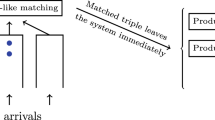Abstract
This paper presents some new perspectives on the time-dependent behavior of the M/M/1 queue. The factorial moments of the queue length as functions of time when the queue starts empty have interesting structure, which facilitates developing approximations. Simple exponential and hyperexponential approximations for the first two moment functions help show how the queue approaches steady state as time evolves. These formulas also help determine if steady-state descriptions are reasonable when the arrival and service rates are nearly constant over some interval but the process does not start in steady state.
Similar content being viewed by others
References
J. Abate and W. Whitt, Transient behavior of regulated Brownian motion, I: starting at the origin, Adv. Appl. Prob., 19 (1987), to appear.
J. Abate and W. Whitt, Transient behavior of regulated Brownian motion, II: non-zero initial conditions, Adv. Appl. Prob., 19 (1987), to appear.
J. Abate and W. Whitt, Transient behavior of the M/M/1 queue via Laplace transforms, Adv. Appl. Prob., 20 (1988), to appear.
J.P.C. Blanc, The relaxation time of two queueing systems in series, Commun. Statist.-Stochastic Models 1 (1985) 1–16.
J.W. Cohen,The Single Server Queue, 2nd ed. (North-Holland, Amsterdam, 1982).
D.R. Cox,Renewal Theory (Methuen, London, 1962).
D.R. Cox and W.L. Smith,Queues (Methuen, London, 1961).
R.A. Doney, Letter to the Editor, J. Appl. Prob. 21 (1984) 673–674.
W. Feller,An Introduction to Probability Theory and its Applications, I, 3rd ed. (Wiley, New York, 1968).
D.P. Gaver, Jr., Diffusion approximations and models for certain congestion problems, J. Appl. Prob. 5 (1968) 607–623.
D.P. Gaver, Jr. and P.A. Jacobs, On inference and transient response for M/G/1 models, Naval Postgraduate School, Monterey, CA, 1986.
D.P. Heyman, An approximation for the busy period of the M/G/1 queue using a diffusion model, J. Appl. Prob. 11 (1974) 159–169.
D.L. Iglehart and W. Whitt, Multiple channel queues in heavy traffic II: sequences, networks and batches, Adv. Appl. Prob. 2 (1970) 355–369.
N.L. Johnson and S. Kotz,Distributions In Statistics, Discrete Distributions (Wiley, New York, 1969).
J. Keilson,Markov Chain Models — Rarity and Exponentiality (Springer-Verlag, New York, 1979).
W.D. Kelton and A.M. Law, The transient behavior of the M/M/S queue, with implications for steady-state simulation, Opns. Res. 33 (1985) 378–396.
I. Lee, Stationary Markovian queueing systems: an approximation for the transient expected queue length, M.S. dissertation, Department of Electrical Engineering and Computer Science, MIT, Cambridge, 1985.
I. Lee and E. Roth, Stationary Markovian queueing systems: an approximation for the transient expected queue length, unpublished paper, 1986.
M. Mori, Transient behavior of the mean waiting time and its exact forms in M/M/1 and M/D/1. J. Opns. Res. Soc. Japan 19 (1976) 14–31.
P.M. Morse, Stochastic properties of waiting lines, Opns. Res. 3 (1955) 255–261.
G.F. Newell,Application of Queueing Theory, 2nd ed. (Chapman and Hall, London, 1982).
A.R. Odoni and E. Roth, An empirical investigation of the transient behavior of stationary queueing systems, Opns. Res. 31 (1983) 432–455.
N.U. Prabhu,Queues and Inventories (Wiley, New York, 1965).
E. Roth, An investigation of the transient behavior of stationary queueing systems, Ph.D. dissertation, Massachusetts Institute of Technology, Cambridge, 1981.
C. Stone, Limit theorems for random walks, birth and death processes, and diffusion processes. Ill. J. Math. 7 (1963) 638–660.
D. Stoyan,Comparison Methods for Queues and Other Stochastic Models, ed. D.J. Daley (Wiley, Chichester, 1983).
L. Takacs,Combinatorial Methods in the Theory of Stochastic Processes (Wiley, New York, 1967).
E. Van Doom,Stochastic Monotonicity and Queueing Applications of Birth-Death Proceses, Lecture Notes in Statistics 4 (Springer-Verlag, New York, 1980).
Author information
Authors and Affiliations
Rights and permissions
About this article
Cite this article
Abate, J., Whitt, W. Transient behavior of the M/M/l queue: Starting at the origin. Queueing Syst 2, 41–65 (1987). https://doi.org/10.1007/BF01182933
Received:
Revised:
Issue Date:
DOI: https://doi.org/10.1007/BF01182933




